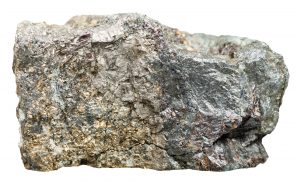What is arsenic and where do you find it?

Arsenic is a naturally occurring element. In the pure form, it is a slivery-gray, semi-metallic substance that tarnishes in air. However, arsenic is found in nature in various inorganic and organic compounds. Inorganic and organic arsenic compounds are white in color, and have no smell or special taste. Inorganic arsenic occurs naturally in certain types of soils and rock formations. Inorganic arsenic compounds are mainly used as a preservative in pressure-treated wood to make it resistant to rotting and decay. Organic arsenic compounds are usually not as toxic as inorganic arsenic compounds, but some are used to make insect killers, weed killers, and fungicides.
Who is exposed to arsenic?
Anyone can be exposed to arsenic since low levels of arsenic are present in soil, water, food, and air. People are primarily exposed to arsenic through eating food (fish and shellfish), drinking water, or breathing air containing arsenic. If wells are drilled in areas where naturally occurring arsenic is present in the soil or rock, drinking water can become contaminated with arsenic. Other sources of exposure are breathing in sawdust or burning smoke from arsenic-treated wood, living near hazardous waste sites, and living in areas with naturally elevated levels of arsenic in rock.
How does arsenic get into and leave the body?
Arsenic enters the body through inhalation or ingestion. Only a minimal amount of arsenic is absorbed through the skin. Both inorganic and organic forms are excreted in urine. Most arsenic leaves the body within several days, although can may remain for several months.
How can arsenic affect my health?
Inorganic arsenic can affect the skin, nervous system, respiratory system, kidneys, and gastrointestinal system. Organic arsenic is much less harmful than the inorganic form of arsenic, but may cause similar health effects at high levels. Most arsenic consumed in seafood is in low-toxicity organic compounds.
Long-term ingestion of inorganic arsenic can cause darkening of the skin and the appearance of small corns or warts on the palms, soles, and torso. Drinking water contaminated with high levels of inorganic arsenic has been associated with increased risk of skin, lung, bladder, and kidney cancer.
Can arsenic affect my unborn child?
Although there is no good evidence that arsenic can harm pregnant women or their fetuses, studies in animals show that doses of arsenic that are large enough to cause illness in pregnant females may cause low birth weight, fetal malformations, or fetal death.
Is there a medical test to show whether I have been exposed to arsenic?

Testing for arsenic may be appropriate if your physician believes you have symptoms that could be caused by arsenic exposure and a potential route of exposure, such as arsenic-containing well water or occupational exposure to arsenic. A urine test is the most reliable means to measure arsenic exposure that has happened within a few days. Tests on hair and fingernails can show if you have had exposure to arsenic over the past 6-12 months, however, these tests have not been correlated with health effects so cannot determine if your health could be harmed.
How can I limit my exposure to arsenic?
If you live in an area where there are naturally high levels of arsenic in the water or soil, limit your exposure to the soil and consider using municipal or bottled water. You can also test your private well water for arsenic, and install a filter if levels are too high. If you work in a job where you may be exposed to arsenic, you may carry arsenic home with you on your clothes or in your hair. Be sure to shower and change your clothes before going home. If you use arsenic-treated wood, be sure to wear a dust mask, gloves, and protective clothing to reduce your exposure to sawdust.
Where can I go for more information on arsenic?
Updated 2023
